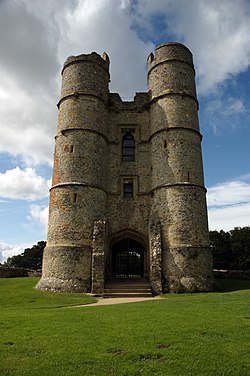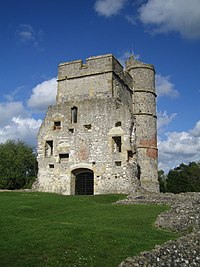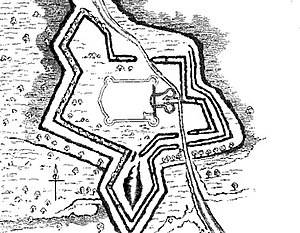Donnington Castle: Difference between revisions
Created page with "{{hatnote|Not to be confused with Castle Donington}} {{Infobox castle |name=Donnington Castle |county=Berkshire |town=Donnington |picture=Donnington.jpg |picture caption=..." |
m →Layout |
||
| (2 intermediate revisions by the same user not shown) | |||
| Line 39: | Line 39: | ||
==Layout== | ==Layout== | ||
[[File:Donnington Castle 1825 plan. | [[File:Donnington Castle 1825 plan.jpg|right|thumb|300px|1825 plan of the castle and Civil War defences. (Demolished parts as unfilled lines)]] | ||
Donnington Castle was originally built in a roughly rectangular form, though the west facade projected outwards irregularly.<ref name=VCH/> It was enclosed by a curtain wall, with a round tower at each of the four corner. Roughly halfway along the two walls running from west to east were two square towers. The courtyard enclosed by the curtain walls would probably have contained a hall, kitchens, and accommodation for guests.<ref name=EH>{{cite web|url=http://www.pastscape.org.uk/hob.aspx?hob_id=233041 |title=Donnington Castle Monument No 233041 |publisher=English Heritage |work=Pastscape |accessdate=18 August 2012}}</ref> Measured from the inner sides of the curtain walls, the courtyard measured 67 feet north to south and 108 feet east to west.<ref name=VCH/> | Donnington Castle was originally built in a roughly rectangular form, though the west facade projected outwards irregularly.<ref name=VCH/> It was enclosed by a curtain wall, with a round tower at each of the four corner. Roughly halfway along the two walls running from west to east were two square towers. The courtyard enclosed by the curtain walls would probably have contained a hall, kitchens, and accommodation for guests.<ref name=EH>{{cite web|url=http://www.pastscape.org.uk/hob.aspx?hob_id=233041 |title=Donnington Castle Monument No 233041 |publisher=English Heritage |work=Pastscape |accessdate=18 August 2012}}</ref> Measured from the inner sides of the curtain walls, the courtyard measured 67 feet north to south and 108 feet east to west.<ref name=VCH/> | ||
| Line 55: | Line 55: | ||
==Outside links== | ==Outside links== | ||
{{Commons}} | {{Commons}} | ||
* | *{{EH link}} - English Heritage | ||
*[http://www.gatehouse-gazetteer.info/English%20sites/3567.html Gatehouse Gazetteer record for Donnington Castle], containing a comprehensive bibliography | *[http://www.gatehouse-gazetteer.info/English%20sites/3567.html Gatehouse Gazetteer record for Donnington Castle], containing a comprehensive bibliography | ||
* | *{{pastscape|233041}} - Donnington Castle | ||
==References== | ==References== | ||
{{reflist}} | {{reflist}} | ||
Latest revision as of 22:09, 1 April 2022
| Donnington Castle | |
|
Berkshire | |
|---|---|
 The twin-towered gatehouse | |
| Location | |
| Grid reference: | SU46106914 |
| Location: | 51°25’10"N, 1°20’15"W |
| Town: | Donnington |
| History | |
| Built from 1386 | |
| Information | |
| Condition: | Ruins |
| Owned by: | English Heritage |
Donnington Castle is a ruined mediæval castle, situated in the small village of Donnington in Berkshire, just north of the town of Newbury. It was founded by Sir Richard Abberbury the Elder in 1386 and was bought by Thomas Chaucer before the castle was taken under royal control during the Tudor period.
During the First Civil War the castle was held by the royalist Sir John Boys and withstood an 18-month siege; after the garrison eventually surrendered, Parliament voted to demolish Donnington Castle in 1646. Only the gatehouse survives.
The site is under the care of English Heritage and is protected from unauthorised change as a scheduled ancient monument.
History
The manor of Donnington had been owned by the Adderbury family since 1292. Donnington Castle was built by its original owner, Sir Richard Abberbury the Elder, under a licence granted by Richard II in 1386. The surviving castle gatehouse dates from this time. In 1398, the castle was sold to Thomas Chaucer, son of the poet Geoffrey Chaucer, as a residence for his daughter Alice, who later became Duchess of Suffolk.
The Duke of Suffolk William De La Pole made Donnington his occasional residence, and considerably enlarged the buildings.[1]
This family, prominent descendants of the House of York, later fell out with the Tudor monarchs, and the castle became a royal property.[2] In 1514 it was given to Charles Brandon, 1st Duke of Suffolk. Though Brandon appears to have stayed at the Donnington Castle in 1516, by the time the castle and manor returned to the Crown in 1535 the structured was in a state of decay.[3] Both King Henry VIII and Queen Elizabeth I visited Donnington Castle, in 1539 and 1568 respectively.[2]
In 1600, Elizabeth I gave the castle and surrounding manor to Charles Howard, 1st Earl of Nottingham.[3] By the time the Civil War broke out in 1643, the castle was owned by the Parliamentarian John Packer family but after the First Battle of Newbury it was taken for the King, Charles I, and held by Sir John Boys. They quickly enhanced the castle's defences by adding earthworks in a star shape to provide gun emplacements.[2] Parliamentarians laid siege to the castle in October 1644 and the garrison held out for 18 months. With permission from the king, Boys surrenedered the castle in April 1646 and was allowed to leave with all his men.[2][3]

In 1646 Parliament voted to demolish the castle; only the gatehouse was left standing though the 17th-century earthworks can still be seen. The castle is now in the care of English Heritage and is a scheduled ancient monument number 233041.[2]
The castle stayed in the Packer family until the mid 18th century, when Robert Packer married Mary Winchcombe, and the property passed into the Winchcombe family tree. From 1833-1881 the manor and castle was owned by Winchcombe Henry Howard Hartley,
Layout

Donnington Castle was originally built in a roughly rectangular form, though the west facade projected outwards irregularly.[3] It was enclosed by a curtain wall, with a round tower at each of the four corner. Roughly halfway along the two walls running from west to east were two square towers. The courtyard enclosed by the curtain walls would probably have contained a hall, kitchens, and accommodation for guests.[2] Measured from the inner sides of the curtain walls, the courtyard measured 67 feet north to south and 108 feet east to west.[3]
During the Civil War star-shaped defences were built around the castle to facilitate gun emplacements. Only the gatehouse, crested by battlements, survived the castle's destruction in 1646;[2] standing three storeys high, it measures 17.5 by 11.75 feet internally.[3] Modern walls standing 2 feet high outline the original layout of the demolished castle. The star-shaped earthworks added during the Civil War are still visible, surviving to a height of 5½ feet.[2]
Pictures
-
Print by William Byrne, 1778
-
Interior of the castle
-
Waste disposal
Outside links
| ("Wikimedia Commons" has material about Donnington Castle) |
- Donnington Castle - English Heritage
- Gatehouse Gazetteer record for Donnington Castle, containing a comprehensive bibliography
- National Monuments Record: No. 233041 - Donnington Castle
References
- ↑ A series of views of the most interesting remains of ancient castles of England and Wales - William Woolnoth et al. 1823
- ↑ 2.0 2.1 2.2 2.3 2.4 2.5 2.6 2.7 "Donnington Castle Monument No 233041". Pastscape. English Heritage. http://www.pastscape.org.uk/hob.aspx?hob_id=233041. Retrieved 18 August 2012.
- ↑ 3.0 3.1 3.2 3.3 3.4 3.5 Shaw-cum-Donnington: Castle - A History of the County of Berkshire: Volume 4, Victoria County History, Pages 87–97}}



